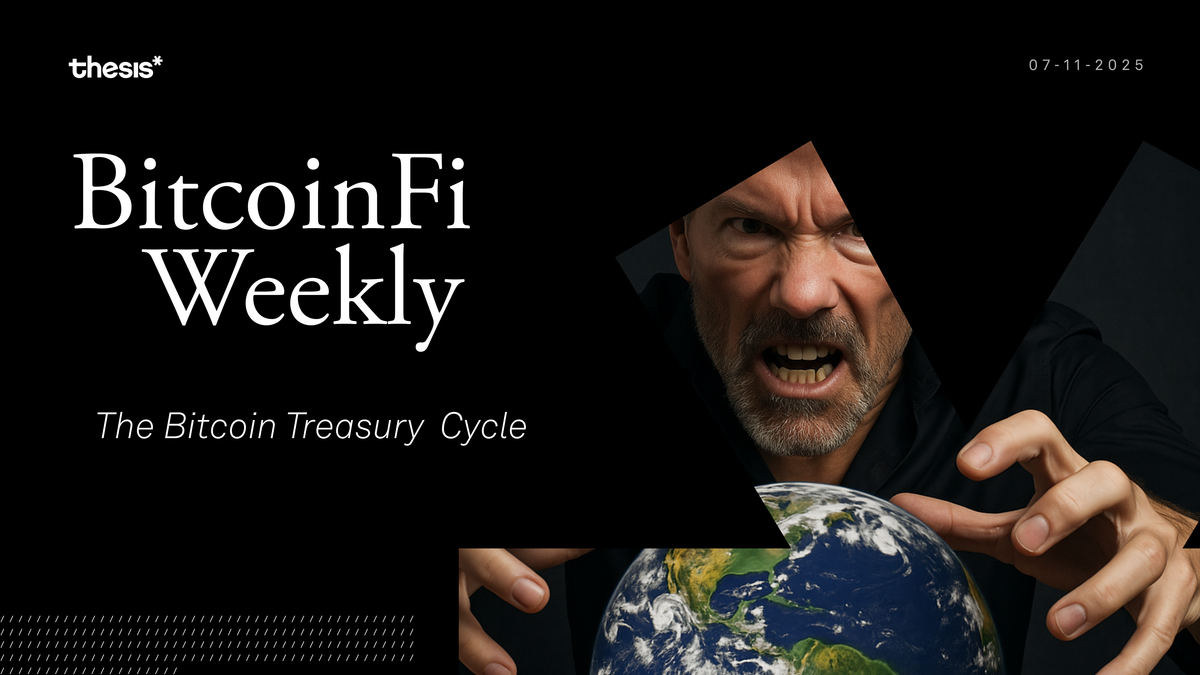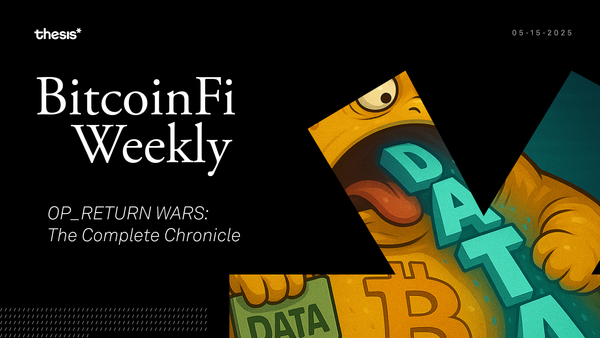The Bitcoin Treasury Cycle
BitcoinFi Weekly returns with insights into BTC’s role in treasuries, TradFi’s silent advance, Strategy’s $4.2B ATM program, Mezo and Botanix mainnets, and stablecoin innovations like Nectra. Stay informed on how Bitcoin is reshaping finance from the ground up.

Welcome to BitcoinFi Weekly. We cover where people use their BTC and what is changing in the Bitcoin world.
After a brief pause, we're back. It’s been barely a month since the dust settled on the OP_RETURN wars, and at first glance, you'd swear the battlefield lay quiet. But quiet is a dangerous word. Beneath the calm surface, TradFi slithers forward silently—companies, big and small, march steadily behind Strategy’s lead. Even the FHFA quietly rewrites its rules, redefining what can back a mortgage—Bitcoin quietly becoming acceptable collateral. And so, day by day, TradFi digs itself deeper into the trenches, unnoticed, unchallenged. Or so it seems...
Here’s this week’s rundown:
🪙 Feature Piece: The Bitcoin Treasury Play
💵 Big Beautiful Bill Analysis
🧠 Strategy’s $4.2 billion STRD ATM program
🚀 Mezo Goes Live
🧱 Nectra: A New Bitcoin-Backed Stablecoin
🕷️ Botanix Goes Live
Feature Piece: The Bitcoin Treasury Play
Strategy was once known only as a dot-com survivor with a stable software business. By 2020, that identity radically changed when Michael Saylor saw an opportunity: Bitcoin as a corporate treasury reserve. The logic was deceptively simple. The company issued debt—initially via convertible notes at nearly zero percent interest—and immediately converted the borrowed dollars into Bitcoin. As Bitcoin’s value climbed, Strategy’s stock price surged, allowing debt holders to convert into increasingly valuable shares.
Quick Glance Timeline
- Aug 2020: Strategy announces first major Bitcoin purchase using cash reserves.
- Dec 2020: Strategy begins issuing convertible notes to buy Bitcoin.
- 2021–2023: Other companies follow, including Tesla, Marathon Digital, Riot Blockchain.
- Early 2024: Strategy issues perpetual preferred shares (STRK, STRF).
- Jan–May 2025: Wave of global corporations announces Bitcoin treasury strategies.
But what really fuels the anatomy of this so-called perpetual motion machine?
The strategy's core isn't Bitcoin itself but the financial engineering used to acquire it. The primary vehicle is the convertible senior note.
Here’s how it works:
- Issue Debt: A company like Strategy issues bonds to institutional investors, raising hundreds of millions or even billions of dollars. These notes carry an extremely low interest rate, often below 1%.
- Buy Bitcoin: The company immediately uses the cash raised from the debt sale to purchase Bitcoin on the open market.
- Stock Price Reaction: The market, seeing the company's Bitcoin holdings increase, bids up the stock price. The stock is no longer valued on its software profits but as a leveraged play on Bitcoin.
- Debt Conversion: The magic happens at maturity. The noteholders have the option to convert their debt into shares of the company's stock at a pre-agreed price (the "conversion price"). If the company's stock has soared far above that price, investors convert, take the stock, and sell it for a handsome profit. The company effectively pays off its dollar-denominated debt with its own appreciated equity.
This is the financial flywheel. Use cheap debt to buy an appreciating asset that inflates your stock, which you then use to pay off the original debt. The only fuel required is the unwavering belief that Bitcoin's price will go up forever.
This strategy has created three distinct classes of corporate players in the Bitcoin ecosystem:
- The Pure Plays (The Hoarders): This is Strategy's camp. Their primary business is now the acquisition and holding of Bitcoin. The software division provides some cash flow, but the stock is the product. Newcomers like Semler Scientific (SMLR) and Japan's MetaPlanet are following this model, explicitly telling investors they are a proxy for Bitcoin.
- The Established Giants (The Dabblers): This group is best represented by Tesla. They made a significant one-time allocation from their existing cash reserves in 2021. They are not actively issuing debt to stack sats. For them, Bitcoin is a treasury asset, not the company's entire reason for being.
- The Original Gangsters (The OGs): These are the Bitcoin miners like Marathon (MARA) and Riot Platforms (RIOT). They were the original corporate treasuries, issuing stock to fund operations and hoarding the Bitcoin they produced. They traditionally offered investors a high-beta play on Bitcoin's price. But with the rise of ETFs and the MSTR playbook, they've seen their premiums erode and are now beginning to issue their own convertible notes to compete.
Seasoned Bitcoiners might recall the GBTC saga. The Grayscale Bitcoin Trust once traded at hefty premiums because investors had no other easy route to Bitcoin exposure. Once direct access improved, GBTC crashed, its premium collapsing into a damaging discount that rippled through crypto markets. Is Strategy’s treasury strategy the new GBTC? Strategy’s play is fundamentally dependent on sustained investor enthusiasm and continually rising Bitcoin prices.
The Bull Case vs. The Bear Case
| Faction | Representative Arguments | Core Belief |
|---|---|---|
The Bulls | 1. First Mover Advantage: Saylor was first, giving MSTR shelling-point status. 2. Leverage is Good: The strategy offers investors leveraged exposure to Bitcoin that ETFs cannot replicate. 3. Infinite Capital: Institutional capital that can't directly hold Bitcoin can still buy equity like MSTR. 4. Long Duration: Long-term debt enables the company to survive prolonged bear markets. | This is the mega-trade of the decade—a structurally superior method for Bitcoin exposure that will attract trillions in capital. |
The Bears | 1. "Number Go Up" Dependency: The strategy breaks down if Bitcoin prices stagnate or fall below debt conversion thresholds. 2. The Piper Must Be Paid: Debt and dividends require actual cash; eventually, obligations must be met. 3. The Exponential Wall: Maintaining Bitcoin-per-share requires raising exponentially more capital, which becomes unsustainable. 4. Crowded Trade: As competitors adopt the model, MSTR’s advantage and premium diminish, breaking the flywheel. | This is a fragile, leveraged trade that introduces systemic risk and will eventually collapse—forcing liquidation of Bitcoin at scale. |
The corporate treasury gambit might just be the defining trade of this Bitcoin cycle.The bulls are right that Michael Saylor identified a massive arbitrage on corporate finance itself. He recognized that in a world of debased currency, a company's stock could become a better claim on a hard asset than the cash on its own balance sheet. For this, he looks like a genius. So far.But the critics are right to be terrified. This is leverage, plain and simple. It’s a strategy built on the single, fragile assumption that the price of Bitcoin will outrun the cost of capital. History is littered with the corpses of those who believed they had found a perpetual motion machine. They are often the same people who forget that Bitcoin's price follows the path of maximum pain.
The proliferation of this strategy across dozens of companies creates a new vector for systemic risk. It's a game of high-stakes musical chairs. The music could play for years. But it will, eventually, stop. The only question is how many chairs will be left when it does.
BitcoinFi Updates
Big Beautiful Bill Analysis
In a landmark legislative shift, the "One Big Beautiful Bill Act" (OBBBA), signed into law around July 4, 2025, fundamentally reshapes U.S. fiscal policy by making the 2017 tax cuts permanent while simultaneously cutting social programs like Medicaid and SNAP, and increasing spending on defense and immigration. The legislation is projected to add over $3 trillion to the national debt over the next decade, providing a modest, short-term stimulus to GDP that is expected to give way to slower long-term growth due to the "crowding out" of private investment from higher interest rates. The bill is also widely anticipated to be inflationary, forcing the Federal Reserve into a more aggressive, long-term tightening cycle, and its provisions are seen as highly regressive, disproportionately benefiting corporations and high-income households while curtailing support for lower-income groups.
For Bitcoin, the repercussions of the OBBBA are entirely indirect yet profoundly significant. The legislation creates a powerful narrative test for Bitcoin. On one hand, the massive increase in the national debt and the inflationary nature of the fiscal stimulus directly fuel Bitcoin's core value propositions as a non-sovereign, fixed-supply "digital gold" and a hedge against currency debasement. On the other hand, the inevitable monetary policy response from the Federal Reserve—higher for longer interest rates—presents a major headwind. This raises the opportunity cost of holding a non-yielding asset like Bitcoin, potentially driving capital towards traditional, interest-bearing investments. The ultimate takeaway is that the OBBBA forces a real-world confrontation between Bitcoin's narrative as a safe haven and its reality as a risk-on asset, making its future performance dependent on whether investors prioritize hedging against fiscal irresponsibility or seeking yield in a tightened monetary environment.
Strategy’s $4.2 billion STRD ATM program
Strategy ($MSTR) has expanded its aggressive bitcoin acquisition strategy, unveiling a new $4.2 billion at-the-market (ATM) offering for its latest 10.00% Series A Perpetual Stride Preferred Stock (STRD). This move complements existing ATM programs (STRK and STRF) and its substantial common stock offerings, underpinning Strategy’s ambitious "42-42" capital plan, targeting $84 billion in combined equity and fixed-income securities through 2027. Leveraging proceeds, Strategy acquired nearly 5,000 BTC ($531.9 million) last week alone, pushing total holdings to 597,325 BTC.
Takeaway — Strategy is trading balance‑sheet agility for raw BTC torque. Near term, issuing 10 % STRD injects cheap cash but drags common holders through another dilution round; with the latest 4,980 BTC bought at ~1.4× average cost, equity value now hinges on bitcoin clearing $100 k just to out‑earn the new coupon and dilution. If BTC stalls, expect credit spreads on senior STRK/STRF to widen as leverage climbs and dividend cover thins. Long term, marching toward the $84 billion “42‑42” target institutionalises perpetual preferreds as quasi‑bonds backed by hard BTC collateral. If Strategy keeps rollover demand humming, it could birth a de facto bitcoin yield curve and cheapen capital across the ecosystem; if market appetite fades, rising coupons would amplify downside, crystallising losses across the capital stack.
Mezo Goes Live
Mezo Mainnet is live, introducing MUSD, the first stablecoin fully backed by Bitcoin, after securing over $400 million in deposits and minting $2 billion during testnet. Users can mint MUSD without selling their Bitcoin, borrowing at fixed rates as low as 1 % and leveraging up to 90 % loan-to-value (LTV).
This enables direct spending and earning through Mezo’s integrated DeFi ecosystem, featuring Velar, Zerolend, BitFi, and Upshift vaults. Audited extensively by Quantstamp and Thesis Defense, Mezo also offers builders EVM-compatible smart contracts with native Bitcoin custody via Wormhole. Additionally, Mezo introduces Tigris, an incentive management system using vote-escrowed Bitcoin (veBTC) NFTs. Locking BTC for veBTC provides governance rights, allowing users to direct protocol revenues and fees, rewarding long-term participants, and promoting ecosystem health.
Check out Mezo’s socials to stay up to date on all feature releases.
Nectra: A Bitcoin-Backed Stablecoin Protocol for Permissionless Loans
Nectra has launched a permissionless, non-custodial Bitcoin-backed stablecoin lending protocol built on Citrea, Bitcoin’s first ZK rollup. Users can now bridge Bitcoin to Citrea, deposit BTC into Nectra, and mint nUSD stablecoins at up to 83.3% LTV.The protocol operates transparently, with smart contracts, eliminating custodial risk, hidden fees, and rehypothecation. nUSD can be used across trading, spending, or earning yield via Nectra’s Savings Account, where users earn revenue from system-generated fees.
Botanix Goes Live
Botanix Labs has launched the mainnet of Botanix, an EVM-equivalent Bitcoin Layer 2 network. The network significantly enhances Bitcoin’s capabilities by enabling rapid transactions (block times reduced from 10 minutes to five seconds) and low fees (averaging $0.02 per transaction).
With active ecosystem partners like Chainlink and Fireblocks, and applications such as GMX and Dolomite, Botanix provides a comprehensive platform for Bitcoin-native financial operations, including trading, lending, borrowing, and staking. Governed by a decentralized federation of industry-leading node operators, Botanix ensures that users maintain full self-custody of their Bitcoin. The network also features "Bitcoin 2100," an immersive gamified experience designed to educate and incentivize participation, marking a significant step forward in making Bitcoin programmable and functional as everyday money.
Closing Thoughts
Beneath the surface, TradFi steadily inches into Bitcoin, transforming narratives and quietly rewriting financial norms. With corporate treasuries betting big and legislation like the OBBBA setting the stage, Bitcoin finds itself navigating an unprecedented landscape—caught between the compelling story of digital gold and the harsh realities of monetary tightening. Yet, amidst this shifting ground, innovation continues unabated, from stablecoins and permissionless lending to new, programmable layers.
If there's a topic you’d like us to cover or have questions, reach out at [email protected].





